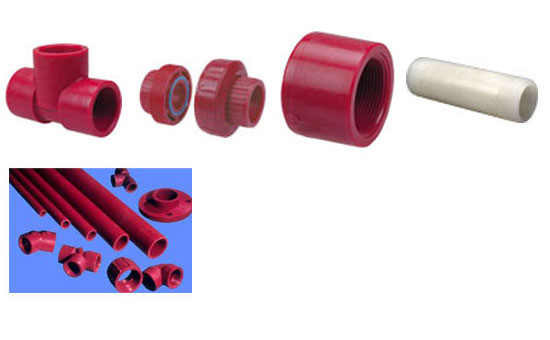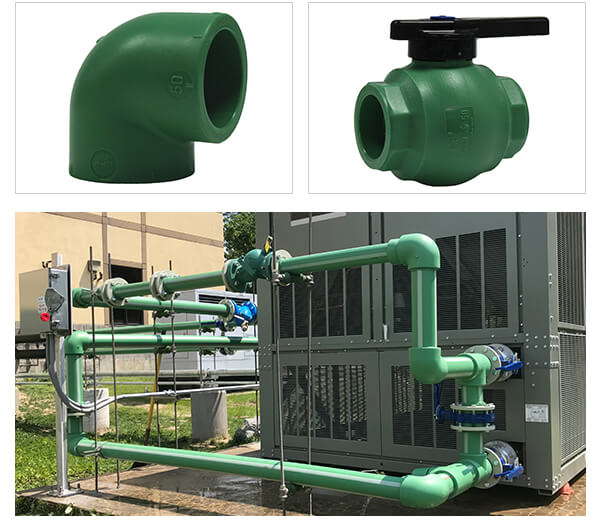Products
Polypropylene and PVDF
PP
(Polypropylene) PP as specified by ASTM D 4101, is a member of the polyolefin family of pure hydrocarbon plastics. Although PP has half the strength of PVC and CPVC, with a design stress of 1,000 psi at 73° F, it may have the most versatile chemical resistance of the thermoplastic materials identified as the sentinels of industrial piping. Consider the fact that there are no known solvents for PP. As a result, it has been the material of choice for drainage of mixed industrial chemicals for over 40 years. As pressure piping, PP has no peers for concentrated acetic acid or hydroxides. It is also suitable for milder solutions of most acids, alkalis, salts, and many organic chemicals, including solvents. The nemeses for PP are strong oxidizers, such as the hypochlorites and higher concentrations of sulfuric, nitric, and hydrofluoric acids. They are Environmental Stress Cracking (ESC) agents for PP, meaning that time to-failure is a function of the combined variables of concentration and temperature of the fluid and stress in the piping material. Although PP is not recommended for some organic chemicals, such as polar and chlorinated solvents and the aromatics, the concern is permeation through rather than catastrophic damage of the molecular chain.
- Available in Black or Natural IPS
- Pipe available in schedule 40 and 80
- Sizes ½”-6”
- Fittings available in IPS socket or threaded connections

PVDF
(Polyvinylidene Fluoride) PVDF homopolymer conforming to ASTM D 3222, Type I, Grade 2, is a tough, abrasion-resistant fluorocarbon material that has a design stress of 1,360 psi at 73° F and a maximum service temperature of 280° F. It has versatile chemical resistance to salts, strong acids, dilute bases, and many organic solvents, such as the aromatics (i.e., benzene ring structure), the aliphadics (i.e., paraffin, olefin, and acetylene hydrocarbons), and the chlorinated groups. And PVDF is ideally suited for handling wet or dry chlorine, bromine, and other halogens. However strong bases, hypochlorites, and some organic chemicals such as polar solvents (e.g., ketones) and esters attack it. No other solid thermoplastic piping material can approach the combined strength, working temperature, and chemical resistance characteristics of PVDF. It is joined by the thermo-sealing socket fusion process, threading, or flanging. The basic PVDF resin is essentially transparent to ultraviolet (UV) radiation, and the plastic material is not degraded by sunlight. However, the fluid medium in a PVDF piping system could be exposed to UV radiation. To provide protection against UV degradation of the fluid medium, an FDA approved red pigmentation is added to all piping components for general industrial consumption, particularly for outdoor installations. Conversely, in certain industries, such as electronics, pharmaceutical, and processed foods and beverages, PVDF has become the piping material of choice because of its high purity, low surface and joint extractables, and elevated temperature sanitation capability. For these applications, another line of piping products made from natural (unpigmented) PVDF is available.
- Available in Red or Natural IPS schedule 80
- IPS Socket Pipe and Fittings available in ½”-6”
- Fittings available in IPS threaded connections ½”-2”

PP-RCT
Asahi/America in partnership with Bänninger of Germany, introduces Asahitec™ PP-RCT piping systems to the North American market.
PP-RCT is the latest advancement in polypropylene polymers and has a wide range of benefits for commercial plumbing systems. It has a more complex crystalline structure that provides greater pressure capabilities at higher temperatures than conventional PP materials. When used in a piping system, these enhanced mechanical properties make it suitable for higher temperature applications such as boiler and hot water systems. They also create lighter and thinner piping, while maintaining the necessary system pressure ratings. PP-RCT can also be extruded in a multi-layer pipe with fiber core middle layer. This core reduces the impact of thermal expansion on the piping system.
Ideal Applications Include:
Potable Water, HVAC – Hot Water and Chilled Water, Food and Beverage Grade Water, Hydronics, Sports Stadiums and Arenas, Commercial Buildings, Residential Buildings, Institutional Buildings, Schools and Universities, Government Buildings, Hospitals, Hotels and Apartments.
